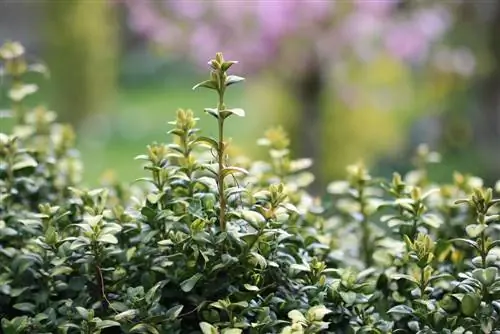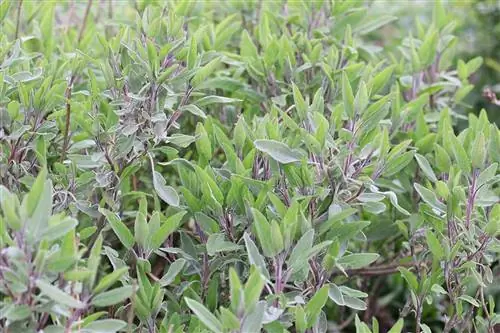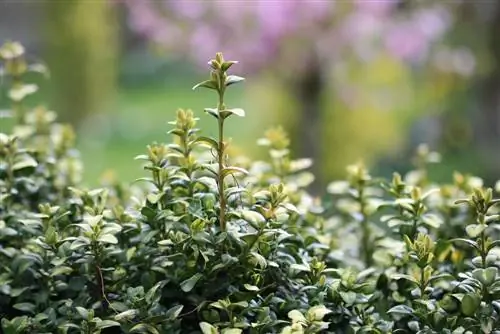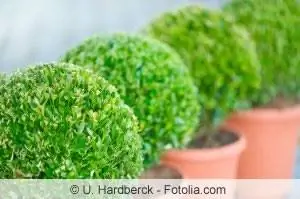- Author admin [email protected].
- Public 2023-12-17 03:39.
- Last modified 2025-01-24 12:45.
Figures made of boxwood are eye-catchers. It doesn't matter whether they are simple geometric figures or whether someone is skilled enough to create elaborate sculptures. The fast-growing boxwood is relatively easy to trim into a specific shape. With a little planning and, for more difficult figures, a template and sharp cutting tools, even inexperienced people can create amazing boxwood figures in the garden. Here we give you some helpful tips.
Location
The boxwood can grow practically anywhere in the garden. It is an undemanding ornamental tree that grows quickly in height and width. As evergreen ornamental trees, boxwood plants look impressive at any time of the year and are therefore popular as hedges, as solitary plants or as container plants. They can be placed in both the sun and the shade, but if you want to cut figures out of your boxwood, you should position it in a conspicuous place. Regular cutting also stimulates growth, so regular fertilization is necessary.
The topiary should take place in spring on a dry, not too sunny day. If there is moisture, the interfaces become susceptible to fungal attack; if there is too much sunlight, the cut branches could dry out.
That's all you need to try making a boxwood figure yourself. There are no limits to your imagination when it comes to design.
Tip:
Make sure that the plant is accessible from all sides, otherwise you will not have enough space for cutting later.
Preparations
You need:
- a very sharp hedge trimmer
- possibly a pair of household scissors for fine cutting
- Stencils, depending on the planned figure
- Wire frames are essential for elaborate figures, some of which are available from specialist retailers
If you're trying to cut boxwood for the first time, you should start with a simple shape. Get a bushy boxwood in a pot; it can be trimmed into a ball relatively easily. A template can be helpful here. It's relatively easy to make yourself. You need:
- a straight stick that is taller than the boxwood
- strong wire that can be bent into a shape and attached to the rod (should be about the strength of a simple clothes hanger)
- a simple clamp that holds the wire in the desired location on the rod
Form a hemisphere out of the wire that is slightly smaller than the boxwood you want to prune, attach the wire to the stick and insert the stick into the ground right next to the trunk. Now you have a fairly accurate template that you can easily rotate around the plant. Anything that extends beyond the template will be cut off.
Since such a wire is relatively flexible, it can also be used for several plants that are different sizes.
Proceed similarly if you want to cut a pyramid out of your boxwood. Just don't form a hemisphere out of the wire, just hold it away from the rod at an angle that corresponds to the approximate growth of the Bux. Now also cut off anything that extends beyond the template. A template for a spiral can be built in a similar way if you do not prefer to purchase a ready-made frame.
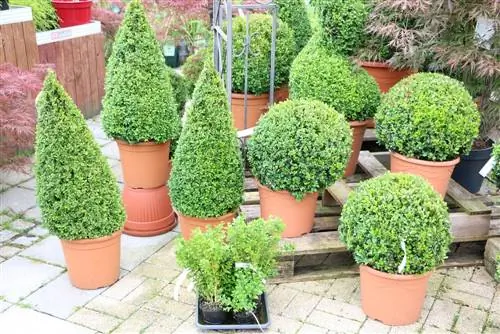
Tip:
In order to create an even shape, the large topiary should be done in April/May; only the regrown shoots can be trimmed several times a year.
Hedge design
A boxwood hedge that is designed in its own right looks stunning. However, patience is required here because despite its rapid growth, the boxwood needs a few years to become dense enough. But soon after planting you can start trimming the hedge into shape. How about, for example, a wave movement within the hedge, along an entire garden path. To do this, you should get different sizes when purchasing the young plants, which will then be planted alternately.
Keep even distances, e.g. B. 5 low and 5 tall plants
In order to create an even look over the entire length of the hedge, you should tension ropes. To ensure that these ropes do not sag in the middle, it is recommended to use two or three additional rods as supports. Now you can cut along the top and bottom lines. To create a rounded wave shape, you can also use a template here.
Masterpieces
It takes several years to create life-size boxwood figures that may become special pieces of jewelry for the garden. What can be seen in old English parks or elsewhere often shows the work of several generations of dedicated gardeners who had no tools. This can be done much more easily today, although it still requires time to grow. But it's never too early or too late to start. Approach it with patience and plan ahead now. If you have a large garden, it would be a nice idea to place a whole group of figures in relation to each other. For example, a whole family of bears, horses or cats. A wide variety of wire frames are available from specialist retailers and can be placed around the desired plant like a cage. Now cut off everything that protrudes beyond the frame. In the first two or three years you will certainly still see holes here and there, which will soon grow over with regular cutting and fertilization. First of all, remember to always cut close to the frame, even if this means the cage is still visible. After three to four years at the latest, you will notice that the wood is increasingly filling the frame and the shape is now clearly visible. This way you get several eye-catching living sculptures at once.
Instructions for shaping a greenhorn
- You need a shrub with five well-developed shoots. Insert three loops of strong wire into the ground or base for the head, torso and wheel.
- Tie three shoots as a wheel, use one shoot each for the head and round. Prune the plant three times a year to fill the mold. The result: a proud peacock!
- For a bird with a long tail, incorporate a stick, cut the rest freely.
As simple as the above instructions sound to grow a magnificent peacock out of a boxwood, this undertaking will really tax your patience: It is true that the boxwood is extremely good for topiary because of its rather small leaves suitable: The tinier the leaves of a boxwood variety, the smaller the circumference from which a grown form can be visually recognized as a figure.
Slow growth
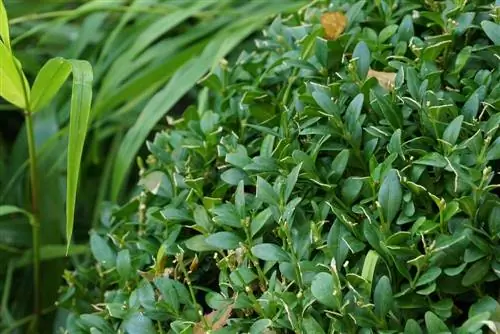
This generally qualifies the boxwood as a plant for complicated topiaries, but unfortunately this fact does not help speed things up when it comes to the individual figure or the specific type of boxwood. Because a boxwood with particularly small leaves grows particularly slowly. And this slow growth will probably become a problem for all impatient people in general, at least if they can hardly wait for their boxwood figure to form:
Box trees do not grow more than a few centimeters each year, between 3 and 15 cm depending on the variety, and you also take a large part of this growth off when you shape the topiary
If you briefly calculate how long a large boxwood figure takes to grow, you will no longer be amazed that a man-sized boxwood figure easily costs 10,000 euros or be surprised that centuries-old boxwood figures like Monuments are maintained. You will rather ask yourself whether you are not already too old to create a magnificent boxwood in your life
For every topiary you need the right boxwood
Because gardeners have been working on the design of boxwoods for several centuries, boxwood breeding has long existed and has now produced a wide variety of varieties. Each variety has its own special properties, which make it particularly recommended as a hedge plant, as a boxwood for path borders and for entire gardens and also as a boxwood for topiaries.
- The more detailed the topiary should be, the smaller the leaves should be and the denser the growth of the boxwood variety should be. However, each variety should be selected based on the greatest growth potential that the respective topiary allows.
- You should inquire very carefully about the properties of the boxwood variety, especially for complicated topiaries that are planned to a certain size.
- Generally recommended for topiaries are the species Buxus sempervirens L. “Blauer Heinz” (for low, small shapes), Buxus sempervirens L. “Herrenhausen” (for flat shapes) and Buxus sempervirens L. “Rotundifolia” and “var. arborescens” (suitable for upright forms).
If you have found the right boxwood, you can then support the creation of your boxwood figure with a wire shape that you can use, for example. B. from the company tropical-world.net from 40764 Langenfeld, go directly to the online shop at www.tropical-world.de.
However, now that you have learned that the time it takes to raise a boxwood figurine can certainly exceed the time it takes to raise your own children, you also know that the most crucial ingredient in the creation of a wonderful boxwood figurine is… There is time, lots of time.
Conclusion
As with all trees, pruning boxwood takes some time. However, simple shapes, such as spheres or pyramids, can be created quite quickly and bring initial success that encourages you to do more. With just a few tools and a lot of patience, true works of art can be created from hedge and solitary plants. This will turn your garden into an individually designed paradise.

